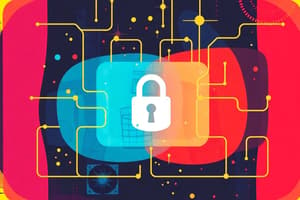Podcast
Questions and Answers
What is the primary purpose of network security?
What is the primary purpose of network security?
- To enhance the speed of network communications
- To protect the integrity, confidentiality, and availability of networks and data (correct)
- To provide internet connectivity to all devices
- To simplify network administration tasks
Which type of firewall inspects the context of traffic packets to decide if they should be allowed or blocked?
Which type of firewall inspects the context of traffic packets to decide if they should be allowed or blocked?
- Proxy firewall
- Stateful inspection firewall (correct)
- Stateless firewall
- Packet-filtering firewall
What does an Intrusion Prevention System (IPS) do in addition to monitoring network traffic?
What does an Intrusion Prevention System (IPS) do in addition to monitoring network traffic?
- It improves internet speed
- It actively blocks detected threats (correct)
- It manages user identities for authentication
- It encrypts data to enhance security
Which of the following authentication methods involves confirming a user's identity through unique physical characteristics?
Which of the following authentication methods involves confirming a user's identity through unique physical characteristics?
What is a common feature of a Virtual Private Network (VPN)?
What is a common feature of a Virtual Private Network (VPN)?
Which of the following represents a common vector for cyber threats aimed at obtaining sensitive information?
Which of the following represents a common vector for cyber threats aimed at obtaining sensitive information?
What is a best practice for improving network security?
What is a best practice for improving network security?
What defines the process of authorization in network security?
What defines the process of authorization in network security?
Flashcards are hidden until you start studying
Study Notes
Network Security
-
Definition: Network security involves measures to protect the integrity, confidentiality, and availability of computer networks and data.
-
Key Components:
-
Firewalls: Hardware or software that blocks unauthorized access while permitting outward communication.
- Types: Packet-filtering, Stateful inspection, Proxy firewall.
-
Intrusion Detection Systems (IDS): Monitors network traffic for suspicious activity and issues alerts.
- Types: Network-based IDS (NIDS), Host-based IDS (HIDS).
-
Intrusion Prevention Systems (IPS): Actively blocks detected threats in addition to monitoring.
-
Encryption: Secures data by converting it into a code to prevent unauthorized access.
- Types: Symmetric (same key used for encryption and decryption), Asymmetric (public and private key pair).
-
-
Access Control:
- Authentication: Verifying identity of users (e.g., passwords, biometrics).
- Authorization: Granting access rights to users based on their identity.
- Accounting: Tracking user actions and access logs for auditing.
-
Network Protocols: Secure communications through protocols like:
- SSL/TLS: Secures data transmitted over the internet.
- VPN (Virtual Private Network): Creates a secure, encrypted connection over a less secure network.
-
Threats:
- Malware: Malicious software designed to harm or exploit any programmable device or network.
- Phishing: Fraudulent attempts to obtain sensitive information by disguising as trustworthy entities.
- DDoS (Distributed Denial of Service): Attack aimed at overwhelming resources to make services unavailable.
-
Best Practices:
- Regularly update software and firmware to patch vulnerabilities.
- Implement strong password policies and multi-factor authentication (MFA).
- Conduct network security assessments to identify and mitigate risks.
- Educate employees about security awareness and phishing tactics.
-
Regulations and Compliance:
- GDPR: General Data Protection Regulation, focuses on data protection and privacy in the EU.
- HIPAA: Health Insurance Portability and Accountability Act, sets standards for protecting sensitive patient information.
- PCI DSS: Payment Card Industry Data Security Standard, security standards for organizations that handle credit card information.
-
Incident Response:
- Prepare an incident response plan to address security breaches.
- Establish a response team and define roles and responsibilities.
- Conduct post-incident analysis to improve security measures.
Network Security Overview
- Network security protects the integrity, confidentiality, and availability of networks and data.
Key Components
-
Firewalls:
- Block unauthorized access while allowing outward communication.
- Types include:
- Packet-filtering: Examines packets for predetermined rules.
- Stateful inspection: Monitors active connections and their state.
- Proxy firewall: Acts as a gateway, filtering traffic between a user and the internet.
-
Intrusion Detection Systems (IDS):
- Monitor network traffic for suspicious activities and provide alerts.
- Types include:
- Network-based IDS (NIDS): Monitors network traffic across segments.
- Host-based IDS (HIDS): Monitors activities on individual devices.
-
Intrusion Prevention Systems (IPS):
- Actively blocks detected threats in addition to monitoring network traffic.
-
Encryption:
- Converts data into a code to prevent unauthorized access.
- Types include:
- Symmetric: Uses the same key for both encryption and decryption.
- Asymmetric: Uses a public key for encryption and a private key for decryption.
-
Access Control:
- Authentication: Confirms user identity through passwords or biometrics.
- Authorization: Provides access rights based on verified identity.
- Accounting: Tracks user actions and maintains access logs for auditing.
Network Protocols
- SSL/TLS: Secures internet data transmission.
- VPN (Virtual Private Network): Establishes a secure, encrypted connection over less secure networks.
Common Threats
- Malware: Software intended to harm or exploit systems.
- Phishing: Fraudulent methods to acquire sensitive information by posing as trustworthy sources.
- DDoS (Distributed Denial of Service): Attacks designed to overwhelm resources, rendering services unavailable.
Best Practices
- Regularly update software and firmware to fix vulnerabilities.
- Implement strong password policies and multi-factor authentication (MFA).
- Conduct network security assessments to identify and mitigate risks.
- Provide security awareness training for employees regarding phishing and other threats.
Regulations and Compliance
- GDPR: Focuses on data protection and privacy rights in the EU.
- HIPAA: Sets standards for protecting sensitive patient health information.
- PCI DSS: Establishes security standards for organizations handling credit card information.
Incident Response
- Develop an incident response plan to manage security breaches effectively.
- Create a response team with defined roles and responsibilities.
- Perform post-incident analyses to enhance future security measures.
Studying That Suits You
Use AI to generate personalized quizzes and flashcards to suit your learning preferences.




